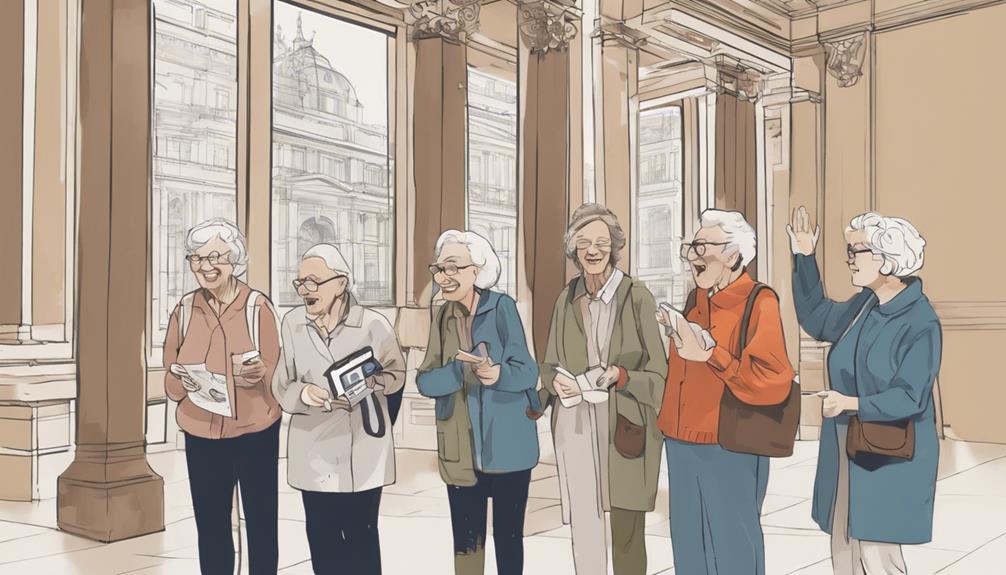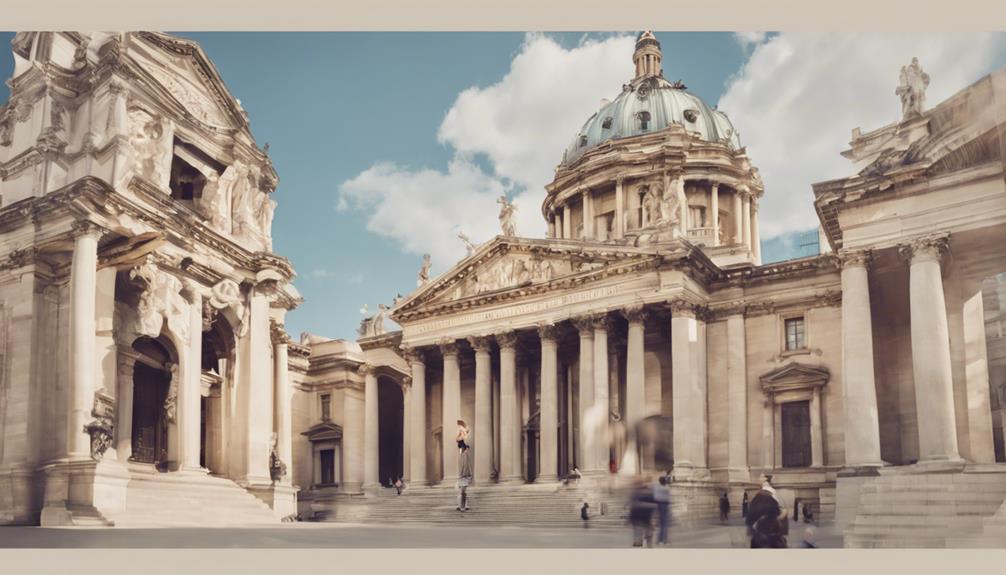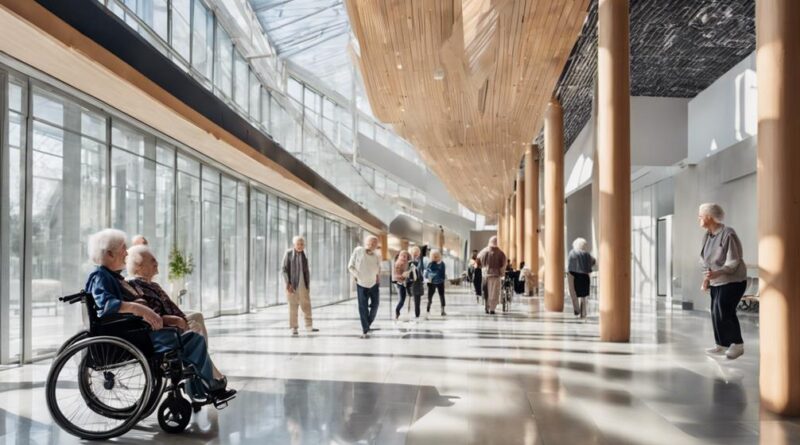Top 10 Tips for Senior-Friendly Architecture Tours"
Embark on enriching architectural explorations tailored for seniors with these ten essential tips. Prioritize ramp access, Braille guides, and safety measures like secure entrances. Opt for small group tours for personalized attention and engagement. Choose comfortable chairs, resting spots, and quiet areas for reflection. Create flexible itineraries and adapt to physical capabilities. Enhance with audio guides and insightful commentary on architecture and cultural influences. Visit iconic landmarks and appreciate diverse architectural styles. Ensure safety while offering meaningful experiences. Uncover historical background, architectural significance, and societal impacts. Connect with architecture's evolution and societal influences.
Consider Accessibility Needs
When planning senior-friendly architecture tours, it's essential to prioritize accessibility needs to ensure all participants can fully engage with the experience. One crucial aspect to consider is ramp access. Installing ramps at key points along the tour route allows seniors with mobility challenges to navigate the architecture seamlessly. Ramps should have a gentle slope, non-slip surfacing, and handrails for added safety. By incorporating ramp access, you create an inclusive environment where all participants can explore and appreciate the architectural wonders without constraints.
Another vital consideration is providing Braille guides. For seniors with visual impairments, Braille guides offer a tactile way to experience the architectural elements. These guides should include detailed descriptions of the buildings, materials used, historical significance, and any other relevant information. By offering Braille guides, you ensure that visually impaired seniors can actively participate in the tour and gain a comprehensive understanding of the architecture being showcased.
Opt for Small Group Tours
To enhance the overall experience and foster a more intimate interaction with the architectural marvels, opting for small group tours is highly recommended. Small group tours provide a conducive environment for interactive engagement with both the guide and fellow participants. This setting allows for personalized attention, making it easier for seniors to ask questions, seek clarification, and actively participate in discussions about the architecture being explored.
Moreover, small group tours offer a deeper level of cultural immersion. With fewer distractions and a more manageable group size, seniors can truly absorb the historical and cultural significance of the architectural sites they visit. Interacting closely with the guide and other participants fosters a sense of community and shared learning experience, enhancing the overall journey.
In small group tours, the pace is often more relaxed, allowing seniors to explore the architectural wonders at a comfortable speed. This leisurely approach caters to the needs of older adults, who may require more time to appreciate and absorb the details of the sites visited. Additionally, the smaller group size enables better coordination and ensures that everyone can hear the guide clearly, enhancing the educational aspect of the tour.
Choose Comfortable Walking Routes
Choosing comfortable walking routes is key to ensuring that seniors can fully enjoy and engage in architectural tours without feeling overwhelmed or fatigued. When planning the tour, consider routes that offer scenic viewpoints to provide both visual interest and opportunities for rest. Select paths that showcase buildings of historical significance, allowing seniors to appreciate the rich architectural heritage while taking leisurely strolls.
To ensure a comfortable experience, opt for routes with smooth surfaces to prevent tripping hazards and reduce joint strain. Avoid steep inclines or stairs whenever possible, as these can be challenging for seniors with mobility issues. Providing frequent resting spots along the route can also encourage seniors to pace themselves and enjoy the tour at their own rhythm.
Incorporating breaks at key points of interest not only allows seniors to rest but also provides opportunities for tour guides to share insights and stories about the architecture they're viewing. By balancing walking segments with informative breaks, seniors can engage with the tour content without feeling rushed or fatigued.
Prioritize Seating Options
Prioritizing seating options is essential for ensuring the comfort and enjoyment of seniors during architectural tours. Comfortable chairs are a key consideration when planning such tours. Opt for seating with adequate back support and cushioning to help seniors relax and avoid strain during longer stops or presentations. Additionally, ensure that the chairs are at an appropriate height for easy sitting and standing, reducing any discomfort or potential falls.
Incorporating rest areas strategically throughout the tour route is another crucial element. These designated spots can offer seniors a chance to take a break, catch their breath, and recharge before continuing. Rest areas should be equipped with comfortable seating options, such as benches or chairs, where seniors can rest their legs and socialize with fellow tour participants.
When selecting seating options, consider the overall layout of the tour. Place chairs strategically at points of interest or where tour guides provide information. This way, seniors can comfortably absorb the architectural details without feeling rushed or fatigued. By prioritizing seating options and ensuring the availability of rest areas, you can enhance the overall experience for seniors on architectural tours.
Allow for Rest Breaks
How can scheduled rest breaks enhance the overall experience for senior participants during architectural tours?
Providing opportunities for rest breaks is essential in ensuring that seniors can fully enjoy and engage with the architectural tour. Incorporating shaded seating areas throughout the tour route allows seniors to take a moment to rest and rejuvenate without being exposed to direct sunlight, which can be particularly taxing for older individuals. These shaded seating spots provide a comfortable and cool environment for seniors to catch their breath, take in their surroundings, and appreciate the architecture around them.
In addition to shaded seating, integrating quiet spaces along the tour path offers seniors a peaceful retreat where they can relax and recharge away from the hustle and bustle of the group. Quiet spaces provide a calming atmosphere for seniors to reflect on what they've seen, ask questions, or simply enjoy a moment of tranquility. These areas can be strategically placed near points of interest, allowing seniors to absorb the architectural wonders at their own pace and in a serene environment.
Schedule Flexible Itineraries
In crafting architectural tours for seniors, incorporating flexible itineraries allows for personalized exploration of sites and accommodates varying mobility levels. Customized experiences tailored to the interests of the group can make the tour more engaging and enjoyable. By scheduling flexible itineraries, tour organizers can adapt the pace and activities based on the group's preferences and physical capabilities. This approach ensures that all participants can fully immerse themselves in the architectural wonders being showcased.
A key aspect of flexible itineraries is the ability to include a variety of engaging activities throughout the tour. For seniors, having the opportunity to participate in hands-on experiences or interactive sessions can greatly enhance their understanding and appreciation of the architecture. Whether it's sketching a building, attending a small workshop, or engaging in discussions with experts, these activities can make the tour more dynamic and memorable.
Moreover, offering flexible itineraries allows for spontaneous discoveries and unexpected finds along the way. Seniors may have specific architectural styles or periods they're particularly interested in, and having the flexibility to accommodate these preferences can lead to a more fulfilling experience. By being open to adjustments and diversions, tour organizers can create a more inclusive and enriching architectural tour for seniors.
Provide Clear Audio Guides

To enhance the architectural tour experience for seniors, ensuring clear audio guides is imperative for facilitating in-depth understanding and engagement with the showcased sites. Enhanced technology in audio guides can significantly benefit senior participants by providing detailed descriptions and historical context about the architectural marvels they're exploring. These audio guides can offer a wealth of information in a format that's easily accessible and can cater to different learning paces.
Interactive experiences through audio guides can further enrich the tour for seniors. Features like interactive maps or the ability to choose specific points of interest can allow seniors to personalize their tour experience, focusing on areas that intrigue them the most. This level of customization can make the tour more engaging and memorable for older participants. Moreover, clear audio guides with well-paced narration can ensure that seniors can comfortably follow along, enhancing their overall understanding and enjoyment.
Incorporating technology-driven audio guides not only aids in delivering information effectively but also adds a modern touch to the tour, making it more appealing to a wider audience. By embracing clear audio guides with enhanced technology and interactive features, architecture tours can become more inclusive and engaging for seniors, providing them with a fulfilling and enriching experience.
Include Visits to Iconic Landmarks
Including visits to iconic landmarks on senior-friendly architecture tours provides a unique opportunity to delve into the rich history and significance of these renowned structures, enriching the overall experience for participants. These landmarks aren't only visually striking but also hold immense cultural significance within their historical context. By including these stops on the tour, participants can gain a deeper understanding of the architectural details and design elements that make these landmarks iconic.
Exploring iconic landmarks allows seniors to witness firsthand the evolution of architectural styles and techniques over different time periods. For example, visiting a historic cathedral may showcase intricate Gothic architecture, while a modern skyscraper highlights contemporary design principles. By observing these contrasts, participants can appreciate the diversity and innovation present in architectural history.
Moreover, delving into the historical context of these landmarks provides valuable insights into the societal, cultural, and technological influences that shaped their construction. Understanding the stories behind these structures enhances the tour experience, giving seniors a more profound connection to the places they visit.
Offer Insightful Commentary

By offering insightful commentary during senior-friendly architecture tours, participants gain a deeper understanding of the historical context and architectural significance of the landmarks they visit. Providing detailed analysis and discussing the architectural features can enrich the tour experience, making it more engaging and educational.
Here are four reasons why insightful commentary is crucial during such tours:
- Contextual Understanding: Insightful commentary helps provide context about the historical background of the landmarks, offering participants a richer understanding of the time period in which they were built.
- Architectural Significance: Delving into the architectural significance of the landmarks allows participants to appreciate the design elements, construction techniques, and artistic influences that make these buildings unique.
- Cultural Relevance: Commentary that explores the cultural influences shaping the architecture can deepen participants' awareness of how societal norms and values have impacted the design and purpose of the landmarks.
- Educational Value: In-depth analysis provided during the tour serves as an educational opportunity, allowing participants to learn about different architectural styles, renowned architects, and the evolution of architectural trends over time.
Ensure Safety Measures Are in Place
Ensuring that comprehensive safety measures are implemented is paramount when organizing senior-friendly architecture tours to prioritize the well-being and security of all participants. To achieve this, it's crucial to have well-established emergency protocols in place. Before the tour commences, brief all participants on emergency procedures, such as evacuation routes and meeting points. Additionally, ensure that all tour guides are trained to handle various emergency situations calmly and efficiently.
When selecting tour locations, prioritize venues with secure entrances. This helps in controlling access to the tour group and minimizes the risk of unauthorized individuals joining. Furthermore, venues with handicap ramps and elevator access should be preferred to ensure all participants can navigate the spaces safely and comfortably.
Regular safety inspections of the tour venues are essential to identify and address any potential hazards promptly. This includes checking for trip hazards, ensuring proper lighting in all areas, and verifying the functionality of safety equipment like fire extinguishers.
In the event of an emergency, clear communication is key. Provide all participants with emergency contact information and designate specific individuals responsible for communicating instructions. By implementing these safety measures, senior-friendly architecture tours can offer an enriching experience while prioritizing the safety and well-being of all involved.
Frequently Asked Questions
Can I Bring My Mobility Scooter on the Architecture Tour?
Yes, you can bring your mobility scooter on the architecture tour. Accessibility options are provided to accommodate different needs.
Prior arrangements for transportation can be made to ensure a smooth experience during the tour.
Feel free to enjoy the tour with the convenience of your mobility scooter, as the tour is designed to be inclusive and cater to various mobility requirements.
Are There Any Opportunities for Hands-On Experiences During the Tour?
During the architecture tour, you can engage in hands-on workshops and participate in various engaging activities. These opportunities provide a deeper understanding of architectural concepts and allow you to interact with the structures in a meaningful way.
From sketching sessions to model-building exercises, the tour offers a range of interactive experiences that cater to different interests and learning styles.
Immerse yourself in the world of architecture through these enriching hands-on experiences.
Will There Be Opportunities to Interact With Local Residents or Architects?
You'll have the chance to delve into local culture and gain valuable insights from architects firsthand during the tour.
Interacting with residents and architects will provide a deeper understanding of the architectural landscape and the stories behind the buildings.
These interactions can enhance your appreciation of the tour and offer a unique perspective on the architectural marvels you'll encounter.
Embrace these opportunities for a richer and more engaging experience.
How Are Emergency Situations Handled During the Tour?
In case of emergencies, the tour guide will explain the emergency protocols and evacuation procedures to ensure everyone's safety.
You'll be guided to designated meeting points and provided with clear instructions on how to proceed. Rest assured that the tour operators prioritize your well-being and have measures in place to handle any unexpected situations efficiently.
Your safety is paramount, and the team is well-prepared to manage any emergency that may arise during the tour.
Can I Request Specific Accommodations for Dietary Restrictions During the Tour?
You can absolutely request specific accommodations for dietary restrictions during the tour. Customized menus and consideration of food preferences are part of the service offered. Just inform the tour organizers in advance about your dietary needs, and they'll ensure that your meals align with your requirements.
This attention to detail ensures that you can fully enjoy the tour without any concerns about the food provided.
Conclusion
In conclusion, implementing these top 10 tips for senior-friendly architecture tours can greatly enhance the experience for older participants.
By considering accessibility needs, providing comfortable walking routes and seating options, and offering insightful commentary, tour organizers can ensure that seniors are able to fully enjoy and appreciate the architectural wonders around them.
Prioritizing safety measures and clear audio guides further contribute to creating a memorable and enjoyable tour for all participants.
